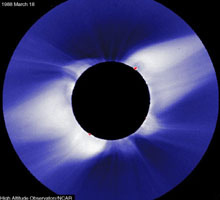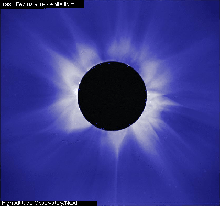|
Forecasting the Sun's Changing Coronal Magnetic Field
To forecast solar storms scientists must develop models of the Sun's coronal magnetic field which
simulate how it changes with time. Understanding and modeling the dynamic behavior of the coronal
magnetic field is key to developing a useful space weather report which will allow scientists to
predict space weather storms.

Image Credit: HAO
|

Image Credit: HAO
|

Image Credit: SOHO
|
The structure of the Sun's outermost layer, the corona, changes dramatically with the 11 year solar
cycle. The above image on the left shows the corona during solar minimum as seen in white light by a
special camera with an occulting disk to create an artificial solar eclipse (a "coronagraph"). The
white light comes from sunlight scattered by particles (electrons) in the corona. Notice the shape of
the corona, which is concentrated near the equator of the Sun. There is very little corona visible
near the poles. In contrast, the middle image shows the Sun's corona during solar maximum. During solar
maximum the corona fills both polar and equatorial regions of the Sun.
The shape of the corona is largely determined by the Sun's global magnetic field. During solar minimum
there are more open field lines near the poles than during solar maximum, these open field lines allow
the coronal gas to escape into space. Closed magnetic field lines contain the gas and help define the
shape of the visible corona. To progress from one magnetic field configuration to the other the Sun must
eject magnetic field and plasma. This is accomplished by giant explosions called Coronal Mass Ejections.
The above image on the right shows a coronal mass ejection just lifting off the limb of the Sun. You
can click on the image to see a movie of several CME's exploding into space.
We'll investigate the process of constructing a coronal weather report on the next pages.
[Next Page]
|

